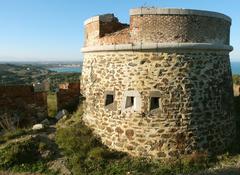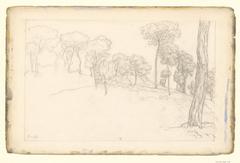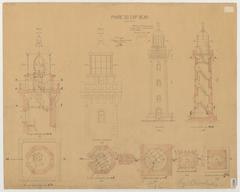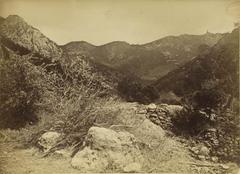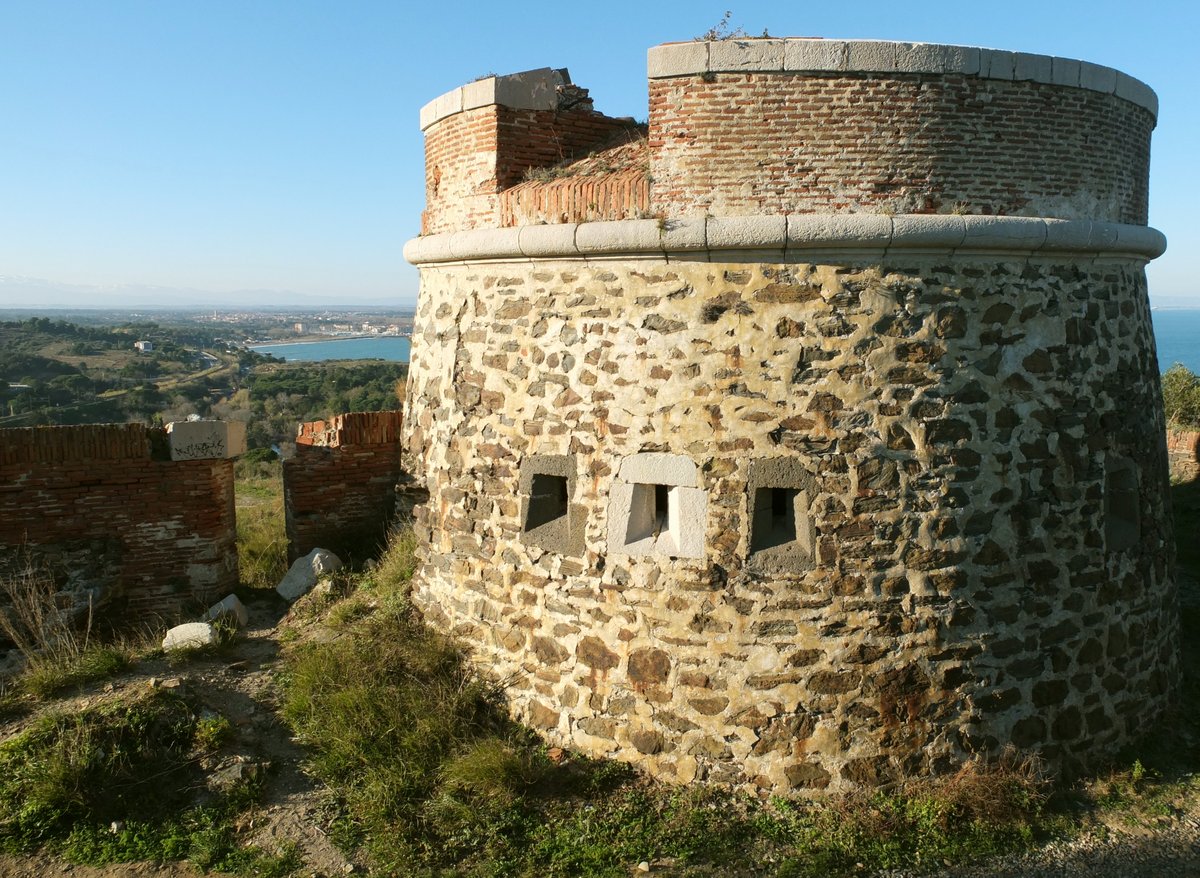
Visiting Torre De L’Estela in Collioure, France: Guide, Tickets, Hours, and Tips
Date: 14/06/2025
Introduction
Torre De L’Estela stands as a sentinel above Collioure, France, offering a compelling blend of medieval history, breathtaking landscapes, and deep cultural roots. Built in the 13th century, this cylindrical stone watchtower formed a crucial link in the region’s coastal defense network, guarding the Roussillon coastline from invasions and pirate raids. Its strategic position provided early warning for Collioure and neighboring strongholds, while its enduring silhouette has become a symbol of the town’s Catalan identity and artistic heritage.
This guide delivers everything you need to know for an enriching visit: Torre De L’Estela’s historical background, architectural highlights, practical visitor info (hours, tickets, and accessibility), travel tips, nearby attractions, and cultural experiences. Whether you’re a history enthusiast, hiker, or culture lover, Collioure’s iconic tower promises an unforgettable journey.
For more on Collioure’s history and tourism, see Petit Futé, the Collioure Tourist Office, and France-Voyage.
Historical Significance and Strategic Purpose
Constructed in the 13th century, Torre De L’Estela (also known as Tour de l’Estel or Estela Tower) was a vital part of a coastal defense chain across the Roussillon region (Petit Futé). Its elevated location enabled visual communication—using smoke by day and fire by night—with other watchtowers and fortresses such as Château Royal de Collioure and Fort Saint-Elme (Wikipedia). This network was especially critical during times of regional tension between the Kingdoms of Aragon, Majorca, and France.
The tower’s robust construction, featuring three internal levels, a cistern for water storage, and a fireplace for signaling, exemplifies the practical needs of its medieval garrison. During regional conflicts and sieges, including those in the 17th and 18th centuries, Torre De L’Estela’s role as an early warning post proved indispensable (Midi France; History Hit).
Architectural Features and Preservation
Torre De L’Estela is distinguished by its cylindrical stone architecture, built from local schist and limestone for durability and harmony with the surrounding landscape (France-Voyage). Its thick walls, narrow openings, and multi-level interior reflect its defensive function. The cistern and fireplace inside highlight the tower’s design for sustained occupation.
After centuries of neglect following its military decline, the tower has benefited from local preservation efforts. Restoration projects have stabilized its structure and improved access, while ongoing community engagement ensures its protection as part of Collioure’s broader heritage initiatives (Petit Futé; Tourisme Collioure).
Cultural and Symbolic Importance
Torre De L’Estela is more than a military relic; it embodies Collioure’s enduring Catalan and Occitan roots. Its name—“Estela,” meaning “star” or “marker” in Catalan—underscores its symbolic role as a beacon for both sailors and the local community (Rick Steves). The tower is frequently featured in art, literature, and local folklore, and is a highlight during cultural festivals such as the Fête de la Saint Vincent.
Artists like Henri Matisse and André Derain drew inspiration from Collioure’s dramatic landscapes, with the tower’s silhouette and panoramic views forming an integral part of the town’s visual identity (French Glimpses). Today, the Chemin du Fauvisme trail celebrates this artistic legacy, guiding visitors through sites immortalized by the Fauvist painters (France Today).
Visiting Torre De L’Estela: Hours, Tickets, and Accessibility
Visiting Hours: Torre De L’Estela is accessible year-round, with no restricted hours. Daylight visits are strongly recommended for safety and the best views.
Tickets: Entry is free; no tickets or reservations are required (France-Voyage).
Accessibility: The approach involves a moderately challenging hike with uneven, rocky trails and elevation gain. The site is not wheelchair accessible and may be unsuitable for visitors with limited mobility (Go Languedoc).
Facilities: There are no restrooms, water fountains, or food vendors at the tower. Prepare by visiting cafés and shops in Collioure’s town center before your hike (France Voyage).
Guided Tours: While not always offered specifically for the tower, local walking and heritage tours often include Torre De L’Estela as part of a broader exploration of Collioure’s history (Cityzeum).
How to Get There
By Train: Collioure is accessible by train via Perpignan, Barcelona, and Paris. The train station is a short walk from the town center and trailheads (Explore Your Bucket List).
By Car: Use the D914 coastal road. Central parking is limited, especially in summer; overflow options are available on the town’s outskirts and via park-and-ride shuttles (Go Languedoc).
Hiking: The most popular trail starts near Château Royal, ascending through vineyards and Mediterranean scrubland. The hike is about 2–3 km each way, with an elevation gain of 200–250 meters, taking 45–60 minutes each way (Explore Your Bucket List).
Practical Tips for Visitors
- Best Time to Visit: May–June and September–October offer mild weather and fewer crowds (Where and When).
- What to Bring: Sturdy hiking shoes, water, sun protection, and weather-appropriate clothing.
- Safety: Trails may be slippery after rain; fire risk can limit access during drought, so check conditions with the Tourist Office.
- Photography: Early morning and late afternoon provide the best lighting for panoramic shots of Collioure, the Pyrenees, and the Mediterranean.
- Family Visits: The hike suits families with older children accustomed to moderate physical activity.
Nearby Attractions and Experiences
- Château Royal de Collioure: Imposing seaside fortress with guided tours and exhibitions.
- Church of Our Lady of the Angels: Iconic waterfront church with a lighthouse bell tower.
- Museum of Modern Art: Showcasing works from Fauvist and contemporary artists.
- Madeloc Tower: Another medieval watchtower offering expansive views.
- Artisan Quarter (Moure District): Explore colorful houses, local crafts, and galleries.
Local Experiences:
- Enjoy traditional festivals like Fête de la Saint Vincent and the Fauvism Trail (Collioure Events).
- Sample Catalan-inspired cuisine and wines in Collioure’s markets and restaurants (Ville Data - Restaurants).
- Take the Little Road Train for a scenic tour or explore local beaches for swimming and snorkeling.
Responsible Tourism and Preservation
Torre De L’Estela is part of a protected landscape. Visitors are asked to stay on marked trails, carry out all litter, and avoid disturbing wildlife (UNWTO Accessibility Guidelines). Community engagement and restoration efforts continue to ensure the tower’s preservation for future generations.
Frequently Asked Questions (FAQ)
Q: What are the visiting hours?
A: Torre De L’Estela is accessible year-round at all hours, though daytime visits are recommended.
Q: Is there an entrance fee?
A: No, the site is free to access.
Q: How difficult is the hike?
A: The hike is moderate and suitable for visitors in good physical condition; not recommended for those with mobility challenges.
Q: Are guided tours available?
A: Yes, some local guides include the tower in walking tours of Collioure’s historical sites.
Q: Where can I park?
A: Main parking is behind Château Royal, with additional options on the outskirts and park-and-ride lots.
Summary and Recommendations
Torre De L’Estela is a captivating destination for anyone exploring Collioure and the Côte Vermeille. Its rich history, panoramic vistas, and integration with the town’s cultural life make it a rewarding stop for hikers, history buffs, and art lovers. For the best experience, visit during spring or autumn, combine the hike with Collioure’s other historical and artistic sites, and embrace the spirit of Catalan hospitality.
For up-to-date travel tips and guided experiences, download the Audiala app, check with the Collioure Tourist Office, and follow local tourism channels.
Sources and Further Reading
- Petit Futé
- France-Voyage
- Explore Your Bucket List
- Official Collioure Tourism
- Wikipedia
- Midi France
- History Hit
- Rick Steves
- French Glimpses
- Tourisme Collioure
- Go Languedoc
- France Voyage (Tourist Office)
- UNWTO Accessibility Guidelines
- Cityzeum
- Where and When
- Ville Data - Restaurants
- Collioure Events
